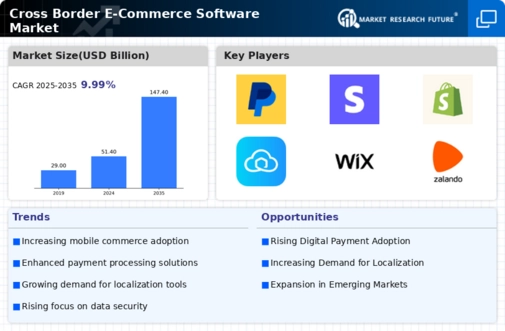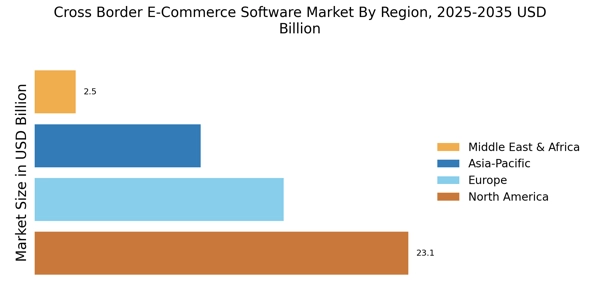Emergence of New Market Entrants
The Cross Border E-Commerce Software Market is characterized by the emergence of new market entrants, which is reshaping the competitive landscape. Startups and small to medium-sized enterprises (SMEs) are increasingly leveraging technology to enter the cross border e-commerce space, often with innovative business models and niche offerings. This influx of new players is fostering competition and driving innovation within the industry. According to recent statistics, SMEs account for a significant portion of cross border e-commerce transactions, highlighting their role in this evolving market. As these new entrants seek to establish their presence, they require robust cross border e-commerce software solutions that can support their unique needs, such as scalability and flexibility. This trend not only enhances market dynamism but also encourages established players to innovate and improve their offerings, ultimately benefiting consumers through a wider array of choices.
Increased Focus on Customer Experience
The Cross Border E-Commerce Software Market is witnessing a heightened emphasis on enhancing customer experience. As competition intensifies, businesses recognize that providing a seamless and personalized shopping experience is crucial for retaining customers. This focus on customer experience encompasses various aspects, including user-friendly interfaces, localized content, and efficient customer service. Data suggests that companies prioritizing customer experience can achieve revenue growth rates of up to 5-10% higher than their competitors. In the context of cross border e-commerce, this means that software solutions must be capable of offering multilingual support, currency conversion, and tailored marketing strategies. By investing in cross border e-commerce software that prioritizes customer experience, businesses can differentiate themselves in a crowded marketplace, ultimately driving customer loyalty and repeat purchases.
Rising Demand for Cross Border Shopping
The Cross Border E-Commerce Software Market is experiencing a notable surge in demand as consumers increasingly seek products from international retailers. This trend is driven by the desire for unique products, competitive pricing, and access to brands not available in local markets. According to recent data, cross border e-commerce sales are projected to reach over 1 trillion USD by 2025, indicating a robust growth trajectory. As consumers become more comfortable with online shopping, the need for software solutions that facilitate seamless transactions across borders becomes paramount. This demand is further fueled by the proliferation of mobile devices and internet access, enabling consumers to shop from anywhere at any time. Consequently, businesses are compelled to adopt advanced cross border e-commerce software to cater to this growing consumer base, ensuring they remain competitive in an increasingly interconnected marketplace.
Technological Advancements in Logistics
The Cross Border E-Commerce Software Market is being propelled by significant advancements in logistics and supply chain management technologies. Innovations such as real-time tracking, automated warehousing, and drone delivery systems are transforming how goods are transported across borders. These technologies enhance efficiency and reduce delivery times, which are critical factors for consumers when shopping internationally. According to industry reports, the logistics sector is expected to grow at a compound annual growth rate of over 7% through 2027, indicating a strong correlation with the growth of cross border e-commerce. As logistics become more sophisticated, e-commerce platforms must integrate these technologies into their operations. This integration not only improves customer satisfaction but also reduces operational costs, making cross border e-commerce more viable for businesses. Consequently, the demand for advanced cross border e-commerce software that can seamlessly incorporate these logistics innovations is likely to increase.
Regulatory Compliance and Trade Agreements
The Cross Border E-Commerce Software Market is significantly influenced by the evolving landscape of regulatory compliance and international trade agreements. As countries negotiate trade deals and harmonize regulations, businesses must adapt their e-commerce strategies to align with these changes. For instance, the implementation of the EU's General Data Protection Regulation (GDPR) has necessitated that e-commerce platforms ensure data protection and privacy for consumers. This regulatory environment creates a demand for software solutions that can navigate complex compliance requirements, thereby facilitating smoother cross border transactions. Furthermore, trade agreements can reduce tariffs and simplify customs procedures, enhancing the attractiveness of cross border shopping. As a result, companies are increasingly investing in cross border e-commerce software that not only streamlines operations but also ensures adherence to international regulations, thereby fostering trust and reliability in cross border transactions.


















Leave a Comment